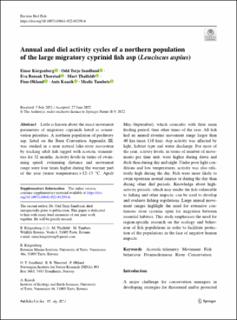| dc.contributor.author | Kärgenberg, Einar | |
| dc.contributor.author | Sandlund, Odd Terje | |
| dc.contributor.author | Thorstad, Eva Bonsak | |
| dc.contributor.author | Thalfeldt, Mart | |
| dc.contributor.author | Økland, Finn | |
| dc.contributor.author | Kaasik, Ants | |
| dc.contributor.author | Tambets, Meelis | |
| dc.date.accessioned | 2022-12-13T11:14:44Z | |
| dc.date.available | 2022-12-13T11:14:44Z | |
| dc.date.created | 2022-08-16T13:59:38Z | |
| dc.date.issued | 2022 | |
| dc.identifier.citation | Environmental Biology of Fishes. 2022, . | en_US |
| dc.identifier.issn | 0378-1909 | |
| dc.identifier.uri | https://hdl.handle.net/11250/3037449 | |
| dc.description.abstract | Little is known about the exact movement
parameters of migratory cyprinids listed as conservation priorities. A northern population of predatory
asp, listed on the Bern Convention Appendix III,
was studied in a near natural lake–river ecosystem
by tracking adult fsh tagged with acoustic transmitters for 32 months. Activity levels in terms of swimming speed, swimming distance and movement
range were four times higher during the warmer part
of the year (water temperatures>12–15 °C, April/May–September), which coincides with their main
feeding period, than other times of the year. All fsh
had an annual riverine movement range larger than
40 km (max 110 km). Asp activity was afected by
light, habitat type and water discharge. For most of
the year, activity levels, in terms of number of movements per time unit, were higher during dawn and
dusk than during day and night. Under poor light conditions and low temperatures, activity was also relatively high during the day. Fish were more likely to
swim upstream around sunrise or during the day than
during other diel periods. Knowledge about highactivity periods, which may render the fsh vulnerable
to fshing and other impacts, can be used to develop
and evaluate fshing regulations. Large annual movement ranges highlight the need for extensive continuous river systems open for migration between
essential habitats. This study emphasises the need for
region-specifc research on the ecology and behaviour of fsh populations in order to facilitate protection of the populations in the face of negative human
impacts. | en_US |
| dc.language.iso | eng | en_US |
| dc.rights | Navngivelse 4.0 Internasjonal | * |
| dc.rights.uri | http://creativecommons.org/licenses/by/4.0/deed.no | * |
| dc.subject | Acoustic telemetry | en_US |
| dc.subject | Movement | en_US |
| dc.subject | Fish behaviour | en_US |
| dc.subject | Potamodromous | en_US |
| dc.subject | River | en_US |
| dc.subject | Conservation | en_US |
| dc.title | Annual and diel activity cycles of a northern population of the large migratory cyprinid fish asp (Leuciscus aspius) | en_US |
| dc.title.alternative | Annual and diel activity cycles of a northern population of the large migratory cyprinid fish asp (Leuciscus aspius) | en_US |
| dc.type | Peer reviewed | en_US |
| dc.type | Journal article | en_US |
| dc.description.version | publishedVersion | en_US |
| dc.rights.holder | © 2022 The Authors | en_US |
| dc.subject.nsi | VDP::Matematikk og Naturvitenskap: 400::Zoologiske og botaniske fag: 480 | en_US |
| dc.source.journal | Environmental Biology of Fishes | en_US |
| dc.identifier.doi | 10.1007/s10641-022-01298-6 | |
| dc.identifier.cristin | 2043466 | |
| dc.relation.project | EU:EU Life+Programme | en_US |
| dc.relation.project | Andre: Estonian Environmental Investment Centre (LIFE+07 NAT/EE/00) | en_US |
| cristin.ispublished | true | |
| cristin.fulltext | original | |
| cristin.qualitycode | 1 | |

